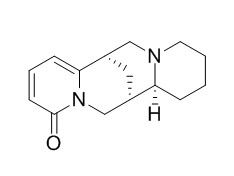Thermopsine
Thermopsine exhibits antibacterial activity.
Inquire / Order:
manager@chemfaces.com
Technical Inquiries:
service@chemfaces.com
Tel:
+86-27-84237783
Fax:
+86-27-84254680
Address:
1 Building, No. 83, CheCheng Rd., Wuhan Economic and Technological Development Zone, Wuhan, Hubei 430056, PRC
Providing storage is as stated on the product vial and the vial is kept tightly sealed, the product can be stored for up to
24 months(2-8C).
Wherever possible, you should prepare and use solutions on the same day. However, if you need to make up stock solutions in advance, we recommend that you store the solution as aliquots in tightly sealed vials at -20C. Generally, these will be useable for up to two weeks. Before use, and prior to opening the vial we recommend that you allow your product to equilibrate to room temperature for at least 1 hour.
Need more advice on solubility, usage and handling? Please email to: service@chemfaces.com
The packaging of the product may have turned upside down during transportation, resulting in the natural compounds adhering to the neck or cap of the vial. take the vial out of its packaging and gently shake to let the compounds fall to the bottom of the vial. for liquid products, centrifuge at 200-500 RPM to gather the liquid at the bottom of the vial. try to avoid loss or contamination during handling.
Microb Biotechnol.2021, 14(5):2009-2024.
Front Nutr.2021, 8: 687851.
Int J Mol Sci.202, 25(17):9246.
J Korean Med Ophthalmol Otolaryngol Dermatol2023, 36(1):21-39.
Reprod Toxicol.2020, 96:1-10.
J Agric Food Chem.2024, 72(15):8784-8797.
BMC Biotechnol.2024, 24(1):94.
Patanjali Research Foundation2024, ssrn.4807357
Nutrients.2020, 12(12):3638.
J Ethnopharmacol.2017, 206:73-77
Related and Featured Products
J Comp Pathol. 1990 Aug;103(2):169-82.
Myopathy in cattle induced by alkaloid extracts from Thermopsis montanta, Laburnum anagyroides and a Lupinus sp.[Pubmed:
2246392]
METHODS AND RESULTS:
A purified alkaloid preparation containing N-methylcytisine, cytisine, 5,6-dehydrolupanine, Thermopsine and anagyrine from Thermopsis montana induced prolonged recumbency and microscopic acute hyaline skeletal myodegeneration with myofibre regeneration in cattle similar in type and severity to that induced by Thermopsis montanta plant material. This indicates that the alkaloid(s) of Thermopsis montana are responsible for the myopathy caused by the plant. An alkaloid preparation containing mostly anagyrine from a Lupinus sp. and an alkaloid preparation containing only cytisine from Laburnum anagyroides each caused microscopic skeletal muscle degeneration and necrosis similar to, but less severe than, the alkaloid extract from T. montana, but without clinical recumbency. Dosage and severity of response suggest that neither of those two alkaloids alone can account for the effects induced by Thermopsis.
CONCLUSIONS:
The data suggest that quinolizidine alkaloids with a alpha-pyridone A-ring may be responsible for the lesions and that individual alpha-pyridones may have additive effects.
Nat Prod Commun. 2012 Aug;7(8):999-1003.
Quinolizidine alkaloids from Sophora velutina subsp. zimbabweensis (Fabaceae: Sophoreae).[Pubmed:
22978215]
METHODS AND RESULTS:
Three novel quinolizidine alkaloids, N-methylenehydroxycytisine (1), 6,7-dihydroxylupanine (2), and velutinine (3) have been isolated from the fruits and pods (1 and 2) and stem bark (3) of Sophora velutina subsp. zimbabweensis along with the known quinolizidine alkaloids, 7-hydroxylupanine (4), Thermopsine (5), N-methylcytisine (6), cytisine (7), an aromatic ester, methyl-3-(3',4'-dimethoxyphenyl)-2-propenoate (8) and the triterpenoids, lup-20(29)-ene-3beta-ol (9) and 12-oleanen-3-one (10).
CONCLUSIONS:
Compounds 6 and 10 showed good antibacterial activity against E. faecalis, with MIC values of 20.8 and 10.9 microg mL(-1), respectively. The other compounds tested exhibited low to moderate antibacterial activity.



